November 13, 2009
Air Date: November 13, 2009
FULL SHOW
SEGMENTS
Tanking Tuna
View the page for this story
Scientists estimate that Atlantic Bluefin populations have decreased by at least 90 percent over the last 50 years, and they warn that if over-fishing continues, the Bluefin species will be a distant memory. The international commission responsible for managing the Bluefin tuna population is meeting in Brazil to decide the fate of this iconic fish. Host Jeff Young visits Boston’s Sensing restaurant to hear about Executive Chef Brendon Bashford’s seafood choices. He then talks with Carl Safina, president of Blue Ocean Institute and adjunct professor at Stony Brook University. Professor Safina is skeptical that the commission will instate adequate protections for the Bluefin. (07:45)
Threatened Albatross
View the page for this story
A coalition of conservationists has been trying to persuade fishing boat owners to adopt measures to reduce the number of seabirds, especially the albatross, killed by the long fishing lines of the tuna fleet. The UK’s Royal Society for the Protection of Birds is part of this effort. Host Jeff Young talks with press officer Grahame Madge about how to protect the seabirds. (04:15)
Stimulating Foreign Economies
View the page for this story
Is the economic stimulus package creating more jobs here in America or abroad? Host Jeff Young asks Rob Gramlich of the American Wind Energy Association to follow the money in the rapidly growing wind power industry. (05:30)
Green Long March
/ Elise PotakaView the page for this story
Students from across China are marching in the streets in an effort to mobilize the public to engage in environmental issues and reduce their carbon emissions. During the past few months, more than a thousand students participated in the Green Long March, visiting renewable energy sites and urging rural and city residents to choose energy efficiency, public transportation and plant trees. Elise Potaka joined one group of students in China’s Inner Mongolia and has our report. (07:25)
Obama in China
View the page for this story
As the climate change summit in Copenhagen draws near, President Obama’s visit to Asia raises speculation about how the U.S. and China will collaborate on reducing greenhouse gases while continuing to use coal-fired power plants. Orville Schell, director of the Center on U.S.-China Relations at the Asia Society, tells host Jeff Young about the difficulties both countries currently face in forming an agreement. (05:05)
Evolution of the Azores
/ Ken ShulmanView the page for this story
The Azores islands are transforming from a poor, underdeveloped island chain to one of Europe’s most technologically and ecologically innovative regions. Azoreans are using the region’s ample geothermal, hydro and wind resources to make the islands energy independent. But can the nine-island archipelago survive its own success, including an increase in population that threatens to strain its resources? Producer Ken Shulman has our story. (08:30)
A Place Called Home
View the page for this story
The strong sense of place that Kate, MaryKate and Katie, three generations of women from one family, experience when they go to their lake house in Connecticut inspired each of them to write poetry. When they heard about the EPA’s Rachel Carson Sense of Wonder contest, the women combined their poems into one. Host Jeff Young talks with these women about their winning poem, A Place of Peace. (08:30)
Show Credits and Funders
Show Transcript
HOSTS: Jeff Young
GUESTS: Carl Safina, Grahame Madge, Rob Gramlich, Orville Schell, Katie Holden, Mary-Kate Holden, Kate Talmadge
REPORTERS: Elise Potaka, Ken Shulman
[THEME]
YOUNG: From Public Radio International, this is Living on Earth.
[THEME]
YOUNG: I'm Jeff Young. Making tough choices for sustainable fish. Decisions rest with international fish commissions and local cooks.
BASHFORD: We’ve just received some beautiful scallops, some fresh live lobsters from Maine, and we also have some tuna.
YOUNG: Not bluefin tuna though. It’s been so overfished stocks have virtually collapsed.
SAFINA: It’s one of the most magnificent creatures in the world, and one of the most incredible fish in the sea. We’ve demolished them and, bite-by-bite, we have eaten most of the ones that used to be in the ocean.
YOUNG: Turning the tide to save the bluefin tuna. Also, growing environmental awareness in China.
[VOICES CHANTING SLOGAN, SPEAKING IN CHINESE]
YOUNG: Chinese students on the Green Long March. Those stories and more this week on Living on Earth, so stick around.
ANNOUNCER: Support for Living on Earth comes from the National Science Foundation and Stonyfield Farm.
[THEME]
Tanking Tuna
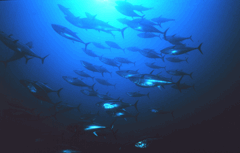
Bluefin tuna (Courtesy of NOAA)
YOUNG: From the Jennifer and Ted Stanley Studios in Somerville, Massachusetts - this is Living on Earth. I’m Jeff Young.
[KITCHEN NOISE; CLANGING METAL; SIZZLING SOUNDS]
YOUNG: On the menu today - sustainable fishing and decisions that could determine the fate of one of the world’s most valuable species of tuna. One big decision - from an international fishing commission. Other decisions – daily in kitchens just like this one.
BASHFORD: Jeff, I’m Brendan Bashford I’m executive chef here at Fairmont Battery Wharf in Boston.
YOUNG: Chef Bashford’s just about to inspect the daily shipment of fish.
[WHIRRING NOISE OF REFRIGERATOR]
BASHFORD: Here we are in our fridge now, Jeff. We’ve just received some beautiful scallops, some fresh live lobsters from Maine, and we also have some tuna.
YOUNG: What’s our tuna look like?
BASHFORD: Our tuna’s very fresh today. It’s Yellowfin, we get whole loins in – it looks nice and ripe.
YOUNG: Mind if I have a sniff?
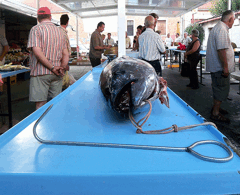
Bluefin tuna in Supetar fish market (Croatia) (Polježičanin. Flickr Creative Commons.)
BASHFORD: No, go right ahead.
YOUNG: [sniffs] Ah, yeah. That’s a beautiful piece of fish, I’ve got to say. But, not Bluefin?
BASHFORD: No, no, not at all. We haven’t used Bluefin – Fairmont, as a company has mandated to us not to use Bluefin for at least a year and a half. So, this is Yellowfin tuna. Bluefin’s on the endangered species list, 97 percent of the fishery stocks of Bluefin tuna have been totally wiped off the earth.
[DOOR CLICKS SHUT]
YOUNG: Chef Bashford wants to educate cooks and customers about sustainable fish choices. Those who fish for the Atlantic Bluefin face tough choices too. The international commission responsible for managing tuna populations in the Atlantic is meeting in Brazil to decide on new catch quotas. But there’s considerable skepticism about whether that body will set adequate protections for the Bluefin. Carl Safina is one of those skeptics. He’s president and co-founder of Blue Ocean Institute and has written extensively about the decline of the Bluefin, a fish he has long admired.
SAFINA: It’s one of the most magnificent creatures in the world, and one of the most incredible fish in the sea, gets to be over 1,000 pounds; one of the very largest fish. It can cross the ocean and swim at highway speeds, it can keep the temperature of its blood about 20 degrees warmer than the surrounding water, so it’s a giant, warm-blooded fish that travels in big herds like buffalo did, except that these are predatory buffalo.

Bluefin tuna sushi (Bunbunlife. Flickr Creative Commons.)
YOUNG: And have you caught Bluefin tuna?
SAFINA: Yeah, I’ve caught them since I was about 12-years-old, but not in the last few years because we’ve demolished them. And bite-by-bite, we have eaten most of the ones that used to be in the ocean.
YOUNG: Tell me about catching a Bluefin. I’m guessing if you haul in a fish that can be longer than you are tall, that’s quite an experience.
SAFINA: Well, the first time I got hooked to a giant Bluefin I was sitting in a chair and I was harnessed to the reel, and had the rod, you know, between my legs, and when the line shot tight I simply got catapulted to my feet. The pressure on the rod was so enormous that my knees began to buckle and I started to go down to the deck. So, that’s the kind of overwhelming power that they are capable of generating.
YOUNG: Now, the Bluefin is really in two major populations, as I understand it. Tell me about where they go over the course of their lives, and what parts of the oceans are most important for the Atlantic Bluefin?
SAFINA: In the Atlantic, Bluefin tuna spawn in two places: in the Mediterranean Sea, and in the Gulf of Mexico. The fish then migrate out, so you have a pretty extensive set of migrations that get a little complicated to try to sort out, but the fish are declining in both populations. The population off the East coast of the US is actually doing much worse in terms of numbers, but the decline is not as bad anymore – it’s kind of stabilized. In the eastern part of the Atlantic, off of – you know, in the Mediterranean and off of Europe and off of West Africa, those fish are many more in number, but they are plummeting in number and declining much more rapidly.
YOUNG: How do we get to the point where a once common fish, just in the course of your lifetime, my lifetime, became something that is right down to, apparently, the bare minimum required for survival?

Bluefin tuna (Courtesy of NOAA)
SAFINA: Well, the ridiculous thing is that in the mid-1960s there was such alarm on the part of the people who were fishing for them at that time that they formed the first international fishery management agency in the world, this Atlantic Tuna Commission. By the mid-1970s, it was estimated that they had declined about 80 percent. Now, when people tell you how much they’ve declined, they say, oh they’ve declined about 80 percent since the mid-1970s, but by then they had already declined 80 percent. So, we probably have about one or two percent of the fish left. We’ve eaten about 99 percent of them.
YOUNG: So, are you at all hopeful that this meeting going on in Brazil might result in something that would place limits that would put us back in line with what scientists say we need to do to let the fish stocks come back?
SAFINA: You could knock me over with a feather if they do anything. The fishing management has done essentially nothing to put in place the quotas that their own scientists suggest.
YOUNG: So, what are the other options, then?
SAFINA: Listing the fish under the convention on international trade of endangered species, which would simply make it illegal to export the fish, regardless of anything the Tuna Commission says or does. That would cut off supplying the market in Japan with any fish that are not landed in Japan by Japanese fishermen. It would not end fishing for Bluefin in the Atlantic, but it would reduce the price so much that a lot of the fishing would ease. And it would actually do something for this fish, which I don’t expect the Tuna Commission to do. I certainly hope they do, but I will be shocked if they do anything significant. What is needed is an international moratorium and an international listing under CITES.
YOUNG: If we were to have those – a moratorium and the CITES listing – what do we know about how a fish like this might come back.
SAFINA: Fish are still breeding and their reproductive potential is absolutely enormous; they lay millions and millions of eggs. Those eggs hatch into very tiny larvae that suffer an incredible rate of natural mortality, but they do spawn classes of juvenile tuna which are noticed up the coast, and if we laid off of those fish and let them get big and let them start spawning, I think we really could allow the fish to recover, and I think they would.
YOUNG: Carl Safina with Blue Ocean Institute and author of “Song for the Blue Ocean.” Thanks for taking time for us.
SAFINA: Thank you so much for having me on.
Related links:
- Atlantic Bluefin Tuna Fact Sheet 1
- Atlantic Bluefin Tuna Fact Sheet 2
- Seafood Guide
- NOAA Press Release
Threatened Albatross

Albatross in the Beagle Channel ( Longhorndave, Flickr Creative Commons.)
YOUNG: The tuna fishery’s also affecting seabirds – including the albatross. Humans have a long history with the albatross – think of the Rime of the Ancient Mariner. You’ll recall things didn’t turn out well for the bird in that story. Thanks to us, many species of these extraordinary birds are in trouble. A coalition of conservationists, including the UK’s Royal Society for the Protection of Birds wants to persuade fishing boat owners to reduce their impact. The Society’s Grahame Madge joins us now – and Grahame – how do these fishing boats kill seabirds?
MADGE: Basically, the problem is when you have a long line paid out from the back of the vessel and every ten meters or so is a hook baited with fish or squid, and that provides a very easy meal for albatrosses, petrels, and other seabirds to try and come in and steal the bait of the back of the hook. The problem is, of course, that occasionally birds do get snagged and then the seabirds get dragged under very quickly and the bird will plum to its inevitable doom, only to be recovered as a corpse several hours later.
YOUNG: Tell me about the status of some of these species; are they more or less stable, or are they already in trouble anyway?
MADGE: There are 22 species of albatross around the world, all of them have a very uncertain future, and 18 of those 22 are reckoned to be facing extinction. And studies, for example, at South Georgia in the south Atlantic have shown that the number of albatross nests counted there between the 1960s and earlier this year have halved. And that the only reason for the loss of those birds is interactions with fisheries, principally, long lining.
YOUNG: So, what is it you want to see done? You’re calling for some sort of measures to mitigate the loss here? What do you want them to do?
MADGE: What we want the tuna fisheries to do is to adopt more mitigation measures. So, for example, if fishing vessels can pay out streamer lines from the back of their vessels that will enable them to build effectively two curtains down either side of the long line, which deters albatrosses and other seabirds from getting too close to that killing zone right at the back of the boat.
YOUNG: So these are a big fluttering streamers that kind of fly out from the back of the boat there – it’s kind of like a scarecrow off the back of the boat, to keep – shoo the birds away?

Albatross in the Beagle Channel (Longhorndave, Flickr Creative Commons.)
MADGE: It’s exactly the same principle as a scarecrow; there are two lines that are tied on to the super structure of the vessel at one end and they’re attached to buoys at the other, which float on the surface of the sea. These buoys are then dragged along by the lines, and then suspended from that line; are basically streamers, which can be brightly colored rubber tubing or ribbon-like material. It flaps in the wind, and amazingly it keeps the seabirds away from the vessel.
YOUNG: And that sounds very low-tech, very low-cost; sounds fairly simply.
MADGE: It does sound very simple when you explain it like that, doesn’t it? But, for some reason there does seem to be some reluctance among fisheries around the world to adopt these very simple measures. We don’t know why – they’re very cheap, they can be repaired if they break, it’s a proven measure. The seabirds, which are the fastest declining group of birds on the planet, don’t have to be declining. It’s largely because of fisheries and the fishing industry could win a PR coup by actually bringing in the measures necessary to protect these birds for future generations.
YOUNG: Now, why focus on the albatross? You’ve sort of made them the poster bird here – why the albatross?
MADGE: The albatross has been the icon of our Save the Seabirds Program. There’s something about an albatross that touches you, even if you’ve not seen one and it’s that that we’ve been tapping into really, this public consciousness toward albatrosses. And when you think that albatrosses can live until they’re 60, be breathing until the age of 50, but lay one egg every two years, when you start losing birds from that population, then that’s really bad news for the individual, but also for the species, itself. The Wandering albatross certainly has the largest wingspan of any bird and it’s a bird that is supremely adapted to its environment. When you see these magnificent creatures in their environment, it makes you realize what a wonderful force evolution is and how terrible it would be if these birds weren’t sail the winds any longer.
YOUNG: Grahame Madge of the Royal Society for the Protection of Birds. Thank you very much.
MADGE: Thank you.
YOUNG: You can learn much more about the albatross and check out a guide to smart seafood choices at our website LOE dot ORG.
[MUSIC: The Wipeouts “Albatross” from ‘Surfin Guitar Hits’ (Mastersong/A-Train)]
YOUNG: Well, coming up – young environmentalists on the march in China – keep listening to Living on Earth!
Stimulating Foreign Economies
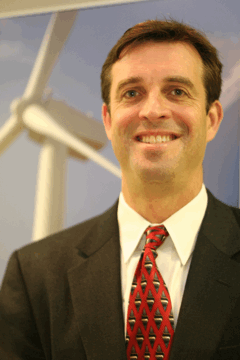
Rob Gramlich (Courtesy of Rob Gramlich)
YOUNG: It’s Living on Earth, I’m Jeff Young. The Obama Administration is betting big on clean energy to generate American jobs, putting more than a billion dollars of economic stimulus cash toward renewable energy projects. But, a proposed wind farm that would put Chinese-made turbines in Texas has some seeing red over green jobs. The joint venture by Chinese and US companies will reportedly seek stimulus act funding to help with the financing. Robert Borosage, with the liberal group Campaign for America’s Future, says that’s not where stimulus money should be going.
BOROSAGE: And the problem was of the 2300 jobs they were going to produce, about 2000 of them were going to be in China where they were going to manufacture the windmills for this wind-farm, and we certainly shouldn’t be willy-nilly subsidizing wind-mills in China which does have an industrial policy around these things because we don’t have one. The clear thing is you need to have a strategy that says we’re going to commit to making certain that America is part of this manufacturing future and to do that we’re going to use a comprehensive industrial policy that will make certain that we help stimulate manufacturing here.
YOUNG: Borosage agrees with New York Democratic Senator Chuck Schumer, who’s urging the Department of Energy to deny the request for stimulus money. The Energy department says its hands are tied; the stimulus act doesn’t give much leeway on such decisions. Caught in the middle of this dust up is the American Wind Energy Association, which represents wind power companies in Washington. Wind Energy Association Vice president Rob Gramlich says the proposed Texas project is not indicative of what’s happening in his rapidly growing industry.
GRAMLICH: Well, that’s an announced proposal to develop a future wind project with a company that has plans to manufacture turbines, but it’s not really representative of all the projects that have already gone up this year, in fact, and that are ready to be deployed. Again, we’ve got a lot of turbines that are going up right now – about five percent of the content comes from China, and the trend is actually towards more US manufacturing.
YOUNG: Mmhmm, but what about this Texas wind farm – is senator Schumer right here, that we should say “no” to that request?

Rob Gramlich (Courtesy of Rob Gramlich)
GRAMLICH: Well, we want the jobs here and we are getting most of the jobs here. I think the intent is to put people to work putting up projects and that’s what we’re doing now. Every project uses some capital equipment, and that capital equipment, if you want shovel-ready projects you kind of have to use what’s available. Now, that project is not one that’s been deployed this year, and again it’s not one that’s really ready to go right away. So, it’s really not indicative of what’s happening with Recovery Act funding for renewable energy.
YOUNG: Okay, so let’s talk about the ones that have been already awarded and are already out there. An investigative reporting workshop at American University looked into the figures – money that had gone out under the Stimulus Act to clean energy via clean energy grants – and found that of the roughly one billion dollars in grants, as of first of the September, 84 percent, about 849 million dollars had gone to what they called foreign wind companies, mostly in Europe.
GRAMLICH: Well, they’re confusing, unfortunately, foreign ownership with foreign jobs. 100 percent of those projects are being constructed here in the US, and will be operated here, and will be providing energy here in the US. There are sometimes foreign companies who are investing, and in fact it’s a way for the US government to leverage investment from both US banks and foreign banks to put in capital into this economy. The projects are here in the US, the jobs are here in the US to put these projects up and operate them. Then, as for the manufacturing, just over 50 percent of the content is American, domestically produced, and the trend is strongly in the direction of more US manufacturing.
YOUNG: Well, give us a report card. Overall, how is the Stimulus Act doing in terms of generating wind projects that are putting Americans to work?
GRAMLICH: The Recovery Act for the wind industry has been a huge success. We’ve had 15 projects that are moving forward this year that likely would not have otherwise. The one billion dollars that have been issued have leveraged about two point four additional billion dollars of private capital. And these projects are quite successful.
YOUNG: And how many jobs associated with those projects? Do we know?
GRAMLICH: Well, we have 85,000 people working in the wind industry, and that was a 2008 number, and again, we’re going to come close to our 2008 number of deployments. So, 85,000 is close, but the challenge really is that while development and project installations are very good due to the Recovery Act. The manufacturing actually has not yet picked up, and the reason is manufacturing is building turbines today before the 2010-11-12 markets. And those markets are still very uncertain.
YOUNG: Rob Gramlich, a senior vice president with the American Wind Energy Association. Thanks a lot.
GRAMLICH: Okay, thank you very much, Jeff.
YOUNG: So what do you think? Visit the Living on Earth Facebook page under groups and let us know!
Related links:
- American Wind Energy Association
- To read Senator Schumer’s letter, click here
- To learn more about the Campaign for America’s Future, click here
[MUSIC: Karsh Kale & Midival Pundits “Synchronicity 2” from ‘Traveler 08’ (Six Degrees Records - 2008)]
Green Long March
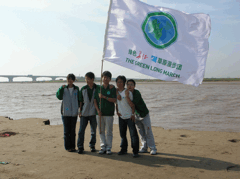
Students on the banks of the Yellow River, just outside Baotou. (Photo: Elise Potaka)
YOUNG: President Obama is on a tour of Asia, which will include high-level talks on climate change in China. China’s already feeling the effects of a warming world. And while the government positions itself for the upcoming Copenhagen climate summit, some younger Chinese are looking for ways they can address the country’s biggest environmental problems. More than a thousand students are traveling seven routes across China, highlighting energy efficiency and renewable sources of power along the way. It’s known as the Green Long March. Elise Potaka joined one group of marchers in China’s Inner Mongolia.
[VOICES CHANTING SLOGAN, SPEAKING IN CHINESE]
POTAKA: In a small refuge of green in the otherwise heavily industrial Chinese town of Baotou, a group of 15 university students carrying banners winds its way through a local park. “Green Long March, save energy, reduce emissions” they chant.
[STUDENTS TALKING ON LOUDSPEAKER]
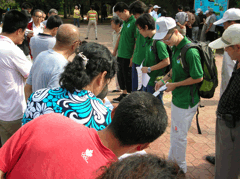
Students talk with locals on the streets on Baotou. (Photo: Elise Potaka)
POTAKA: The students are taking part in the northern-most route of what’s become an annual pilgrimage for China’s eco-conscious students – the Green Long March. Over the next two weeks, they’ll wind their way across Inner Mongolia, researching different industries and case studies, and promoting environmental protection.
[VOICE ON LOUDSPEAKER]
POTAKA: With an eye on Copenhagen, this year’s march has focused on promoting energy efficiency and renewables. In the centre of the park, the students set up information stands and a cube which represents the amount of CO2 the average Chinese person emits every four hours. Park-goers – young and old - gather round; the students urge them to choose public transportation over private cars, plant trees, and use energy saving light bulbs.
[MEN TALKING IN CHINESE]
POTAKA: Some in the park are not convinced that “laobaixing” or everyday people can really make a difference. China’s population is just too big, they say. Student leader, Liu Shiyi, counters that this is one of the country’s greatest assets.
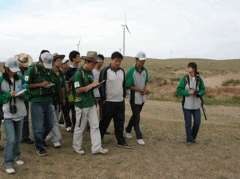
At a wind farm, students talk about China’s environmental challenges. (Photo: Elise Potaka)
[SHIYI SPEAKING CHINESE]
VOICEOVER: China’s large population can be seen as a disadvantage, but it also means that if we all work together, we have a lot of power to protect the environment.
POTAKA: Pointing to the brown haze over Baotou, and the factories in the distance, onlooker, Mr. Zhang, says pollution is inevitable as China develops.
[ZHANG SPEAKING CHINESE]
VOICEOVER: In western countries, it’s very common to ban private cars in some parts of the city, and only let buses or police cars move freely. But this is the outcome of a country’s development, and China is just at the beginning. You can't stop these sorts of things now.
POTAKA: But Miki, a journalism student from Beijing disagrees that nothing can be done.
[MIKI SPEAKING CHINESE]
VOICEOVER: Sometimes I think the environment and the economy are in conflict, but our economy has already reached a certain level, and we all understand the importance of environmental protection. Yes, problems exist, but the first step is to realize this and then we can improve the situation. So that’s why our activity today is important.

Students on the banks of the Yellow River, just outside Baotou. (Photo: Elise Potaka)
[VOICES TALKING; PARK ATMOSPHERE]
POTAKA: The Green Long March – now in its third year – is not just about increasing public awareness, it also involves researching different industries and case studies. Most of the students in this group are studying science, and will go on to work in China’s heavy industries – the source of much of the country’s pollution. Industry accounts for around a third of China’s coal use, as well a quarter of its water consumption. Outdated or inefficient technologies continue to hamper environmental progress.
[WIND FARM SOUNDS; VOICES SPEAKING]
POTAKA: A few hours out of Baotou, in the rolling grasslands of the Inner Mongolian steppe, the students arrive at a wind farm. Against a backdrop of massive wind turbines, they ask the owner detailed questions about wind energy. Many of the marchers, like 21-year-old, Liu Shiyi, see the march as a way to find out more about green technologies, which might be able to make a difference in their future workplaces.
[SHIYI SPEAKING CHINESE]
VOICEOVER: After I graduate I might work in a large-scale steel factory. Today’s research will be really useful for me in the future because I’ve discovered that although many steel factories are using technology to reduce their pollution, it’s still not ideal. If I do enter this industry, I hope I can find a find a scientific way to maintain production output as well as protecting the environment.
[PIG SOUNDS; RURAL SOUNDS; STUDENTS TALKING]
POTAKA: Next stop is Quan Feng Village, where the students survey a biogas project that was awarded a small grant as part of the Green Long March. They take detailed notes as village head, Chen Yong Lia, describes the benefits of using pig waste to generate biogas for cooking and heating.
[CHEN SPEAKING CHINESE]

A sign promotes biogas and wind energy near Quanfeng Village. (Photo: Elise Potaka)
VOICEOVER: In the past using coal, we would consume at least 3 tons per year to warm the house and cook food. Now we just need one ton. We also used to burn the wood and corn stalks for energy, but since using biogas we can mulch the stalks or sell them as animal feed.
[FOOTSTEPS; VOICES ECHOING IN KITCHEN]
POTAKA: Villager Lu Haixia turns on the kitchen’s gas cooker to demonstrate the biogas. The students have a lot of questions. Is there any smell, they ask? Does it still work in winter? How much money has the system saved residents? They find that the majority of villagers are using the biogas and are happy with the system.
[STUDENTS SINGING ON BUS]
POTKAK: A bus sing-a-long is just what the group needs to relax at the end of what’s been a busy day. With more than 5,000 students involved more broadly in Green Long March activities, participants, like 22-year-old management student Zuo Ran, are quick to point out that they’re not a minority among people their age.
[ZUORAN SPEAKING CHINESE
VOICEOVER: The people around me have all started to consider the environment. For example, we live in a dormitory. If one person forgets to turn off a tap, someone else will quickly do it. While it’s only a really small action, the important thing is that everyone feels a sense of responsibility.
[VOICES; CLAPPING SOUNDS]
POTAKA: Back in Beijing, at the closing ceremony for the green long march, Zhang Long Shuai, from the Inner Mongolia University of Science and Technology, says it’s important that the Copenhagen climate summit has some real outcomes.
[LONG SHUAI SPEAKING CHINESE]
VOICEOVER: Our carbon emissions have already exceeded the safe level of 350 parts per million. I hope the government does more to advocate public participation in environmental protection, energy-saving and emission reducing activities, and that they implement the policies so it’s not just a conference, or an empty slogan.
POTAKA: Now back in class, the students are busy telling others about what they experienced on their green long march. They hope to draw in new recruits not only to their environmental network, but to the philosophy that underpins it. For Living on Earth, I’m Elise Potaka in Beijing.
Related link:
Green Long March – Future Generations/China
Obama in China
YOUNG: As we mentioned, climate change will be on the agenda when President Obama visits Beijing. No international climate treaty is possible without the world’s two biggest carbon polluters, who still have a world of differences to overcome. Orville Schell directs the Center on US-China Relations at the Asia Society in New York. Mr. Schell, what can the president’s trip do to put a larger climate change agreement within reach?
SCHELL: Well one hopes that the US and China could effect some sort of a new collaboration. But the United States does not have a lot of money to put on the table, and when China thinks of leadership from the United States, that’s one of the things that is certainly on the table. We’ve had many memoranda of understanding and what we’re looking for here is the next sort of quantum leap in collaboration – a concrete project of some sort between the two countries, aimed at ameliorating climate change.
YOUNG: So, if we’re lacking the cash to sweeten the deal, might sharing energy technology be a way to achieve that?
SCHELL: Well, I think China’s very interested in sharing technology with the United States and I think there are some arrangements where the government could ensure risk.
YOUNG: What are we talking about there, ensure risk?
SCHELL: Well, many American companies are extremely worried that if they allow their technology to transfer to China, that China will reverse engineer it, and in effect steal it. And so, if there was a way for governments to ensure that technology would not be stolen, and if it was, there would be some payback. This would facilitate things.
YOUNG: I guess the larger issue with technology sharing though, is we’re also technology competitors. I mean most people in the US look at China and think, that’s the competition here.
SCHELL: Well, this is true, and yet there are times when you look at certain kinds of drugs that we make available that government ensures lower cost for developing countries – for instance in Africa. But, it might behoove the two governments to find a way to actually buy or license certain kinds of technology that would be useful in both countries. And in effect subsidize it so companies can make money and the technology at the same time can be tested and used. So, if the US can find a way to do some of its testing here and at the same time collaborate with China to some there. That would be the best outcome, but it gets down to a question of who’s got the resources to do it.
YOUNG: Your center recently published a paper on how we might share technology on what’s called “carbon capture and storage”. This is about ways to strip the CO2 from the emissions, from primarily coal-fired power plants. What do you think is possible there?
SCHELL: Well, I think carbon capture and sequestration is the answer to the continued use of coal. Now, we did release a roadmap that sort of suggests how the Obama administration could cooperate immediately with China on this front. We’re not saying this is the only area that begs cooperation, nor are we saying that it is the best area. We’re saying it is one of a number of inevitable areas that we need to collaborate on. Energy efficiency would be another; renewable energy would be a third. China, I think it’s fair to say, is waiting for the United States to reassume a leadership role in this field and whether we will be able to rise to the occasion remains to be seen.
YOUNG: What do we know about the conservation ethic in China, in general? Is this an area where the Chinese public feels strongly, is motivated to act?
SCHELL: More and more, China and the Chinese populous at large are becoming aware of the consequences of kinds of environmental degradation that they are experiencing firsthand. In the last two or three years I’ve seen a literally stunning evolution of consciousness of the dangers of climate change in China. Now, I think leaders really do begin to understand this has grave long-term consequences, and rather serious short-term consequences, even for a country like China. To wit, the melting of the glaciers in the Himalayas and the Caracorum, where every major river’s relying on these watersheds.
YOUNG: What’s the likelihood of a kind of meaningful deal coming from the President’s trip, or Copenhagen, or any other summit coming down the road?
SCHELL: Well, I’m not tremendously optimistic that the President’s trip can actually move the mountain. And part of that reason is Congress – is that without the United States making some investment in a remedy, and in collaboration with China, and that takes money and I don’t think Congress is about to do that. It’s going to be very hard to do what needs to be done unless the US and China get together. And unless we find a way to get together, especially around the question of coal, we will not find a remedy for climate change globally.
YOUNG: Orville Schell directs the Center on US-China Relations at the Asia Society in New York. Thanks very much.
SCHELL: A pleasure.
[MUSIC: Quantic “Seas and Trees” from ‘Mishaps Happening’ (Ubiquity - 2004)]
YOUNG: Just ahead – the old homestead that brought three generations together in verse – stay with us on Living on Earth.
ANNOUNCER: Support for the environmental health desk at Living On Earth comes from the Cedar Tree Foundation. Support also comes from the Richard and Rhoda Goldman fund for coverage of population and the environment. And from Gilman Ordway for coverage of conservation and environmental change. This is Living On Earth on PRI, Public Radio International.
Evolution of the Azores
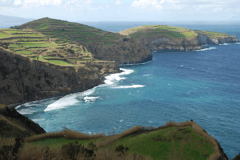
The spectacular northeast coast of San Miguel. The pastures are bordered by the incienso shrub, whose aggressive roots contribute to soil erosion. (Photo: Ken Shulman)
YOUNG: It's Living on Earth, I'm Jeff Young. When Portuguese settlers first arrived at the Azore islands in the 15th century, they found what looked to be paradise. Lush vegetation carpeted the volcanic islands. Rock cliffs plunged to the sea, and there were even naturally heated pools of water. But the settlers also found active volcanoes and frequent earthquakes that made nature seem more foe than friend. Ken Shulman visited the Azores and found attitudes about nature on the island beginning to change.
[VOICES SINGING AND CHANTING TOGETHER]
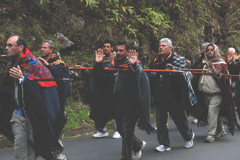
A group of religious pilgrims walks and chants for eight days around the island of San Miguel. (Photo: Ken Shulman)
SHULMAN: A group of ragged pilgrims in woolen shawls chants Ave Maria in Portuguese. Draped in rosaries, carrying wooden staffs, they trudge along the northeast coast of San Miguel, the largest of the Azore islands. The annual pilgrimage dates back to 1532. That’s when settlers first took to the road in a show of penitence after an earthquake leveled their town. Frederico Cardigas is regional director for environmental affairs in the Azores. He says piety and natural disasters still go hand in hand here.
CARDIGAS: They are very connected to catastrophes, because they have volcanoes, they have storms, they have earthquakes, and they are very intense when they happen. And, they destroy peoples’ lands and sometimes they destroy even lives.
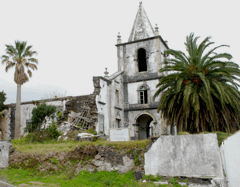
Ruined buildings are a common sight in the Azores. This church on the island of Faial was destroyed in a 1998 earthquake. (Photo: Ken Shulman)
SHULMAN: The Azore islands are set in the Atlantic Ocean, 1,000 miles off the coast of Lisbon. The archipelago straddles the seam of three tectonic plates: North American, Eurasian, and African. Earthquakes are frequent. But these days Azoreans have learned to make geology their friend.
[MACHINE SOUNDS AT GEOTHERMAL PLANT]
SHULMAN: San Miguel’s 130,000 inhabitants get nearly 40 percent of their electricity from geothermal plants like this one in Ribera Grande, San Miguel’s second largest city. Carlos Alberto Bicudo da Ponte is managing director of Sogeo, the company that runs the facility.

The spectacular northeast coast of San Miguel. The pastures are bordered by the incienso shrub, whose aggressive roots contribute to soil erosion. (Photo: Ken Shulman)
DAPONTE: As you see in this landscape there is around steam coming up easily from the earth. This shows the evidence of the content of the energy beneath our feet.
SHULMAN: The Ribera Grande plant runs 24 hours a day and is powered by steam and water. Da Ponte walks me through the orderly tangle of turbines and conduit tubes anchored into a volcanic shelf overlooking the sea.
DAPONTE: It’s very important from a strategic point of view and from the economical point of view to use our indigenous resource, which make our economy more strong and also make us more autonomous in what’s concerned energy. And also, because as you see the environmental impact is very low.
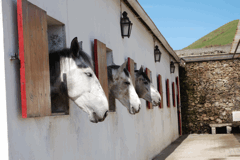
With EU subsidies drying up, many San Miguel dairy farmers are moving into agrotourism. (Photo: Ken Shulman)
SHULMAN: Renewables account for nearly 30 percent of all electricity in the Azores. The rest comes from imported fuel oil, which is pricey and pollutes. Regional officials hope to up the percentage of renewables to 75 by 2018, with a combination of geothermal, hydro, and wind power. Keeping the Azores green is environmentally sound. And green looks good on a region becoming increasingly dependent on tourism.
[COWS CHEWING GRASS]
SHULMAN: But looks can be deceiving. The site of these cows munching grass on the hilltops of San Miguel looks like a billboard for bucolic bliss. Dairy is the island’s most important industry, a loose network of family-owned farms that produce high quality milk, butter, and cheese, primarily for export. But Frederico Cardigas says these man-made pastures are creating major problems for San Miguel. Especially now that climate change has made rains more intense.
CARDIGAS: The soil now has grass instead of forest. And this is also a problem because the grass is not prepared to grab the soil. It’s a problem because if the rain is not captured by the forests then the water is not available for the distribution in the urban areas.
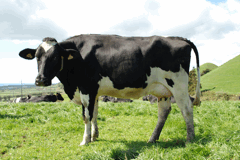
Dairy is the most important industry in the Azores. San Miguel alone counts over 1700 dairy farms. (Photo: Ken Shulman)
SHULMAN: Incenso, the imported shrub that farmers used to mark their land is also contributing to soil erosion. With no native species to keep it in check, incenso has spread all over San Miguel. The roots dislodge trees and even cause landslides. Cardigas says both situations are serious.
CARDIGAS: The best solution of course would be for the natural environment to fight back. And this will happen, because there is this natural trend that native species will adapt for the foreign ones and the foreign ones to native species and they will find a balance. But this will take time, probably hundreds of years and we need answers now.
SHULMAN: Ironically, in this historically impoverished region, the biggest challenge may come from prosperity. Over the past two decades, the Azores have received major European Union investments for infrastructure, industry, and tourism. New highways and the possibility of employment lure many locals to urban areas, changing island lifestyles and landscapes.
[WIND SOUNDS]
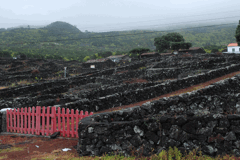
Protected by basalt rock walls, the Pico Vineyards are a UNESCO World Heritage Site. (Photo: Ken Shulman)
SHULMAN: The island of Pico is a bumpy 45-minute flight from San Miguel. The dominant feature is a snowcapped volcano that shares the island’s name. Beneath the massive cone spread these vineyards. A UNESCO world heritage site, the Pico Vineyards are a broad, vaguely lunar maze of dry volcanic rock walls. The walls protect the vines from winds and rain, which are often fierce enough to cancel the 20-minute ferry between Pico and Faial Island. Architect Antonio Vargas takes the ferry every Friday from Faial to tend the family vineyard on Pico. Over dinner, he tells me he’s the last of a kind.
VARGAS: I know the day that I stop working those vineyards they go to waste because there is no one to follow in my footsteps. I don’t see it. Most of the families and men that are in their fifties or are sixty-year-olds right now look back and saying this ends here. This is a lot of agriculture; horticulture; viniculture will stop with this generation when this generation comes to an end.
SHULMAN: Vargas knows the future of the Azores lies in tourism. He’s sad about the end of the traditional island lifestyle. But his livelihood doesn’t depend on it. The same isn’t true for the hundreds of Azoreans leaving family farms to seek work in the city. Pedro Moura is a journalist and hosts of Bom Dia Acores, the morning television news broadcast out of San Miguel.
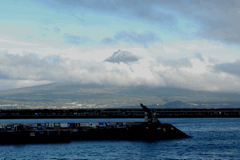
At 7713 feet, the Pico Volcano is the highest point in the Azores and in all of Portugal. The last eruption occurred in 1963 in waters just off the coast. (Photo: Ken Shulman)
[WATER SOUNDS]
MOURA: The rural family in all the islands, they have the possibility to have their own subsistence guaranteed by like a small production in the backyard of the house with one cow, one pig, or one chicken.
SHULMAN: We’re standing on a high cliff overlooking the sea in Rabo de Peixe, an old fishing village on the north coast of San Miguel. Behind us, scores of unemployed boys and men linger near a small church on the town square, smoking, and drinking coffee or brandy a few minutes before noon. Most of them are from rural families recently moved here to cramped, prefab apartments with no space for gardens.
MOURA: They don’t want to work the land; they have no possibilities in the city to have land. So these people, these are the poor and low media class that have problems now.
SHULMAN: There will be more urbanization all across the Azores as EU agricultural subsidies taper off in a few years according to schedule, and as more people in Europe and North America discover its savage, pristine beauty. Tourist visits have increased by nearly 20 percent a year since 2004, and for the first time in more than a century, the Azores are receiving migrants instead of losing their population abroad. For the moment, all these currents are modest. But they’ll need to be managed. Because even if they’re no longer living off the land, Azoreans know their survival will always depend on nature, and on their efforts to preserve it.
[CHURCH BELLS CLANGING]
SHULMAN: For Living On Earth, I’m Ken Shulman, in Rabo de Peixe in the Azores.
[MUSIC: Joe Satriani “Clouds Race Across The Sky” from ‘The Electric Joe Satriani’ (Sony Music - 2003)]
A Place Called Home
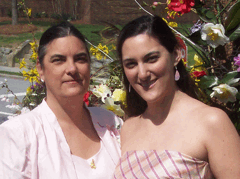
Mary Kate and Katie Holden
YOUNG: Ours is a mobile society. But no matter where we roam, many of us still feel a strong connection to the home-place. For the Talmadge family, that place is a humble house in the Connecticut woods. It’s inspired three generations of poets. This year, the three women, Kate, Mary-Kate, and Katie, combined their poems into one and entered it in a contest sponsored by the Environmental Protection Agency: the Rachel Carson Sense of Wonder contest. And, they won! We have all three poets on the line from Durham, North Carolina. First of all, congratulations!
ALL: Thank you!
YOUNG: Now, who am I talking to – let’s see who’s who here?
KATIE: I’m Katie Holden, and I’m Mary-Kate’s daughter, and Kate’s granddaughter.
MARY-KATE: This is Mary-Kate Holden, and I’m in the middle.
KATE: And I’m Kate, the matriarch, the oldest one at 92.
YOUNG: Now, before we hear the poem, “Place of Piece,” I wonder, where are we in this poem? What’s the setting?
MARY-KATE: The setting is at a home in Lidfield County, Connecticut, which has been in our family for about 100 years, and it’s a place where all of us have spent summers and no matter how far away we go from it, we always try to get back there for a short period of time. And it’s a very natural setting, there’s no radio and there’s no TV, and there’s a lot of water, and it means a great deal to all of us in the family.
YOUNG: Well, since you all three wrote the poem, I’d like for you all three to read it for us, if you don’t mind?
MARY-KATE: Okay, we can each read the part that we wrote.
YOUNG: Okay!
KATE: Knee-deep in purple asters, where maples gaily spill,
Unwept living crimson on our firm New England hill,
Our little half-built house awaits you, serene and still.
Such peace is here
And quiet dreaming.
No din of fear
Like sirens screaming
Or brass bells tolling, no dark hate rolling
That troubles the wind-washed silence under
These white clouds flying.
Only the crying of a far bird calling
Like a feather falling
That flutters earthward from above.
Warm as the sun that softly spills
Its life-giving light across the hills,
Kindling the crimson apples for the day of your returning.
MARY-KATE: When sunwashed sky turns crimson gold
And cool breezes fall from top of hill
Bringing clouds of bat food buzzing still
My heart stills quiet
And my mind breathes
Lulled after the day's chores done. Memories wash over
Of small children laughing in silver drops of water,
Of teenagers dunking and gliding on skis and
Blushing under other's gazes peeking through clover.
My family founded in elder days
Continues the call that Nature makes
For our souls returning to this place of peace,
Where time stands still until we say
Who we are and where we are from.
KATIE: I am from the Lake (wet, warm, natural)
I am from the lily, dogwood, earth, planted in the front yard.
My mother’s earth. I'm from long trips and dark features.
From the long line of Kate's and of Robert.
I'm from the stubborn and matriarchal.
From magic curtains and brownie kisses.
I'm from tall altars and winding passages with spires from the sky.
I'm from Europe- France, England, Germany, Ireland, Scotland,
A mutt all around.
From the broken butt to being my rock and storms.
The stubborn women through and through
I am from the old, dust, moths, mold.
I am from mothers and lakes and lots of people,
With love.
YOUNG: Very nice. I want to go there. I tell ya, I want to go there.

Mary Kate and Katie Holden
KATIE: Everybody does!
MARY-KATE: You’re all invited to camp.
YOUNG: It sounds lovely. I want to ask about a few lines that stood out here: I’m from the stubborn and matriarchal.
[Laughs]
KATIE: That part - we have very strong women in our family.
YOUNG: I gathered that.
KATIE: Yes. And I am very proud to be one of those women, and hopefully, one day I can be such a big presence that my mom and my grandmother are.
YOUNG: Kate, does that hold true for your memories of your mother, your grandmother? Strong women all the way back?
KATE: Well, yes. But we’re all different people and my grandmother bought the property in 1910, so our hundredth anniversary is coming up. I wrote my part of this poem in World War Two when my husband was over in the war in Europe for about four years right after we were married. And this poem started out initially as a love letter to him. To contrast our home with the blood spilling and the bombs dropping and the sirens screaming over in Europe.
MARY-KATE: The wonderful thing about her part of this poem is that this place and the memories of this place, it was an anchor for my father when he was in the war.
YOUNG: There is such a strong sense of place being expressed through this poem and through your comments, and yet, you don’t live in this area anymore. But, real home is this house, yeah?
KATIE: Yeah. This is how I explain it. I explain it that my home is in Greensborough, but my heart is in Connecticut.
MARY-KATE: We have very long roots – they extend for a long distance.
KATE: And our family has spread out all through the United States. Some of us are out in California, some in Florida, some in Maine. And we all go back there. We would drift apart if it weren’t for our place in Connecticut.
KATIE: And when I went to college, at that time I didn’t really realize how much that place meant to me. And that summer, when I was able to go back, it was like I was going home. My heart was at peace and I really had some much more respect for this place that I had left and started on my own.
MARY-KATE: The wonderful thing about this place is that all the generations are there all the time. You have the newborn babies in their little place and the parents and teenagers are watching the kids dunking each other. And the matriarchs and the elders looking on for afar and trying to keep up with everyone’s names. And it was like that when my mother was small, it was like that when I was small, it was like that when Katie was small. And it continues to be that way.
YOUNG: Tell me about poetry in your family.
MARY-KATE: It’s just a part of us. We’re all very creative people. Poetry is way of expressing ourselves and it allows us to revisit some of our experiences in some of our feelings.
YOUNG: And Kate, was that something you tried to instill in your daughter and your granddaughter – a love of poetry?
KATE: I always loved poetry and grew up writing it as a little girl, and I think that Mary-Kate and Katie have also done that, too. We just like to write.
KATIE: And for me, I have learning disabilities, and for me poetry is a way to get out what I actually feel about something. And I’ve written so much about the lake it seems so natural just to combine our poems and make it into one big kind of story of a life of a place.
YOUNG: Kate, I’m wondering, what’s your earliest memory of that property, of that house?
KATE: Well, it’s a very interesting piece of property. It used to be a hayfield full of beautiful wild flowers. And it has evolved through all my 92 years into a typical New England Hardwood Forest. As a little girl I loved every rock, and every tree that I could climb and I used to name them, and all the enchanting butterflies and little bugs and caterpillars and wildlife has evolved from this beautiful hayfield into a forest with deer, wild turkeys, foxes, coyotes. And the whole landscape has been in evolution like all of us.
YOUNG: Kate Talmadge, Mary-Kate and Katie Holden, thank you all very much.
ALL: Thank you, oh, you’re very welcome.
YOUNG: Ours is a mobile society. But no matter where we roam, many of us still feel a strong connection to the home-place. For the Talmadge family, that place is a humble house in the Connecticut woods. It’s inspired three generations of poets. This year, the three women, Kate, Mary-Kate, and Katie, combined their poems into one and entered it in a contest sponsored by the Environmental Protection Agency: the Rachel Carson Sense of Wonder contest. And, they won! We have all three poets on the line from Durham, North Carolina. First of all, congratulations!
ALL: Thank you!
YOUNG: Now, who am I talking to – let’s see who’s who here?
KATIE: I’m Katie Holden, and I’m Mary-Kate’s daughter, and Kate’s granddaughter.
MARY-KATE: This is Mary-Kate Holden, and I’m in the middle.
KATE: And I’m Kate, the matriarch, the oldest one at 92.
YOUNG: Now, before we hear the poem, “Place of Piece,” I wonder, where are we in this poem? What’s the setting?
MARY-KATE: The setting is at a home in Lidfield County, Connecticut, which has been in our family for about 100 years, and it’s a place where all of us have spent summers and no matter how far away we go from it, we always try to get back there for a short period of time. And it’s a very natural setting, there’s no radio and there’s no TV, and there’s a lot of water, and it means a great deal to all of us in the family.
YOUNG: Well, since you all three wrote the poem, I’d like for you all three to read it for us, if you don’t mind?
MARY-KATE: Okay, we can each read the part that we wrote.
YOUNG: Okay!
KATE: Knee-deep in purple asters, where maples gaily spill,
Unwept living crimson on our firm New England hill,
Our little half-built house awaits you, serene and still.
Such peace is here
And quiet dreaming.
No din of fear
Like sirens screaming
Or brass bells tolling, no dark hate rolling
That troubles the wind-washed silence under
These white clouds flying.
Only the crying of a far bird calling
Like a feather falling
That flutters earthward from above.
Warm as the sun that softly spills
Its life-giving light across the hills,
Kindling the crimson apples for the day of your returning.
MARY-KATE: When sunwashed sky turns crimson gold
And cool breezes fall from top of hill
Bringing clouds of bat food buzzing still
My heart stills quiet
And my mind breathes
Lulled after the day's chores done. Memories wash over
Of small children laughing in silver drops of water,
Of teenagers dunking and gliding on skis and
Blushing under other's gazes peeking through clover.
My family founded in elder days
Continues the call that Nature makes
For our souls returning to this place of peace,
Where time stands still until we say
Who we are and where we are from.
KATIE: I am from the Lake (wet, warm, natural)
I am from the lily, dogwood, earth, planted in the front yard.
My mother’s earth. I'm from long trips and dark features.
From the long line of Kate's and of Robert.
I'm from the stubborn and matriarchal.
From magic curtains and brownie kisses.
I'm from tall altars and winding passages with spires from the sky.
I'm from Europe- France, England, Germany, Ireland, Scotland,
A mutt all around.
From the broken butt to being my rock and storms.
The stubborn women through and through
I am from the old, dust, moths, mold.
I am from mothers and lakes and lots of people,
With love.
YOUNG: Very nice. I want to go there. I tell ya, I want to go there.
KATIE: Everybody does!
MARY-KATE: You’re all invited to camp.
YOUNG: It sounds lovely. I want to ask about a few lines that stood out here: I’m from the stubborn and matriarchal.
[Laughs]
KATIE: That part - we have very strong women in our family.
YOUNG: I gathered that.
KATIE: Yes. And I am very proud to be one of those women, and hopefully, one day I can be such a big presence that my mom and my grandmother are.
YOUNG: Kate, does that hold true for your memories of your mother, your grandmother? Strong women all the way back?
KATE: Well, yes. But we’re all different people and my grandmother bought the property in 1910, so our hundredth anniversary is coming up. I wrote my part of this poem in World War Two when my husband was over in the war in Europe for about four years right after we were married. And this poem started out initially as a love letter to him. To contrast our home with the blood spilling and the bombs dropping and the sirens screaming over in Europe.
MARY-KATE: The wonderful thing about her part of this poem is that this place and the memories of this place, it was an anchor for my father when he was in the war.
YOUNG: There is such a strong sense of place being expressed through this poem and through your comments, and yet, you don’t live in this area anymore. But, real home is this house, yeah?
KATIE: Yeah. This is how I explain it. I explain it that my home is in Greensborough, but my heart is in Connecticut.
MARY-KATE: We have very long roots – they extend for a long distance.
KATE: And our family has spread out all through the United States. Some of us are out in California, some in Florida, some in Maine. And we all go back there. We would drift apart if it weren’t for our place in Connecticut.
KATIE: And when I went to college, at that time I didn’t really realize how much that place meant to me. And that summer, when I was able to go back, it was like I was going home. My heart was at peace and I really had some much more respect for this place that I had left and started on my own.
MARY-KATE: The wonderful thing about this place is that all the generations are there all the time. You have the newborn babies in their little place and the parents and teenagers are watching the kids dunking each other. And the matriarchs and the elders looking on for afar and trying to keep up with everyone’s names. And it was like that when my mother was small, it was like that when I was small, it was like that when Katie was small. And it continues to be that way.
YOUNG: Tell me about poetry in your family.
MARY-KATE: It’s just a part of us. We’re all very creative people. Poetry is way of expressing ourselves and it allows us to revisit some of our experiences in some of our feelings.
YOUNG: And Kate, was that something you tried to instill in your daughter and your granddaughter – a love of poetry?
KATE: I always loved poetry and grew up writing it as a little girl, and I think that Mary-Kate and Katie have also done that, too. We just like to write.
KATIE: And for me, I have learning disabilities, and for me poetry is a way to get out what I actually feel about something. And I’ve written so much about the lake it seems so natural just to combine our poems and make it into one big kind of story of a life of a place.
YOUNG: Kate, I’m wondering, what’s your earliest memory of that property, of that house?
KATE: Well, it’s a very interesting piece of property. It used to be a hayfield full of beautiful wild flowers. And it has evolved through all my 92 years into a typical New England Hardwood Forest. As a little girl I loved every rock, and every tree that I could climb and I used to name them, and all the enchanting butterflies and little bugs and caterpillars and wildlife has evolved from this beautiful hayfield into a forest with deer, wild turkeys, foxes, coyotes. And the whole landscape has been in evolution like all of us.
YOUNG: Kate Talmadge, Mary-Kate and Katie Holden, thank you all very much.
ALL: Thank you, oh, you’re very welcome.
Related link:
To read Kate, MaryKate and Katie’s poem, as well as winners in other categories, click here
[MUSIC: Bill Frisell “Ghost Town/Poem For Eva” from ‘Ghost Town’ (Nonesuch Records - 2000)]
YOUNG: Living on Earth is produced by the World Media Foundation. Our crew includes Bobby Bascomb, Eileen Bolinsky, Bruce Gellerman, Annie Glausser, Ingrid Lobet, Helen Palmer, Jessica Ilyse Smith, Ike Sriskanderajah, and Mitra Taj, with help from Sarah Calkins, Marilyn Govoni and Sammy Souza. Special thanks today to Andy Levitt, and James Curwood. Our interns are Quincy Campbell and Nirja Parekh. Jeff Turton is our technical director. Alison Lirish Dean composed our themes. Steve Curwood is our executive producer. You can find us anytime at LOE dot org. I’m Jeff Young. Thanks for listening.
ANNOUNCER 1: Funding for Living On Earth comes from the National Science Foundation supporting coverage of emerging science. And Stonyfield farm, organic yogurt and smoothies. Stonyfield pays its farmers not to use artificial growth hormones on their cows. Details at Stonyfield dot com. Support also comes from you, our listeners. The Ford Foundation, The Town Creek Foundation, The Oak Foundation—supporting coverage of climate change and marine issues. The Bill and Melinda Gates foundation, dedicated to the idea that all people deserve the chance at a healthy and productive life. Information at Gates foundation dot org. And Pax World Mutual Funds, socially and environmentally sustainable investing. Pax world for tomorrow. On the web at pax world dot com.
ANNOUNCER 2: PRI – Public Radio International.
Living on Earth wants to hear from you!
Living on Earth
62 Calef Highway, Suite 212
Lee, NH 03861
Telephone: 617-287-4121
E-mail: comments@loe.org
Newsletter [Click here]
Donate to Living on Earth!
Living on Earth is an independent media program and relies entirely on contributions from listeners and institutions supporting public service. Please donate now to preserve an independent environmental voice.
NewsletterLiving on Earth offers a weekly delivery of the show's rundown to your mailbox. Sign up for our newsletter today!
 Sailors For The Sea: Be the change you want to sea.
Sailors For The Sea: Be the change you want to sea.
 The Grantham Foundation for the Protection of the Environment: Committed to protecting and improving the health of the global environment.
The Grantham Foundation for the Protection of the Environment: Committed to protecting and improving the health of the global environment.
 Contribute to Living on Earth and receive, as our gift to you, an archival print of one of Mark Seth Lender's extraordinary wildlife photographs. Follow the link to see Mark's current collection of photographs.
Contribute to Living on Earth and receive, as our gift to you, an archival print of one of Mark Seth Lender's extraordinary wildlife photographs. Follow the link to see Mark's current collection of photographs.
 Buy a signed copy of Mark Seth Lender's book Smeagull the Seagull & support Living on Earth
Buy a signed copy of Mark Seth Lender's book Smeagull the Seagull & support Living on Earth

